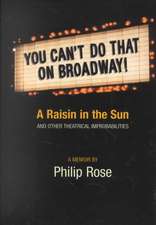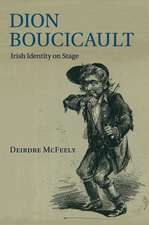Structural Design for the Stage
Autor Alys Holden, Bronislaw Sammler, Bradley Powers, Steven Schmidten Limba Engleză Hardback – 17 mar 2015
Now in hardcover, with nearly 200 new pages of content, it has been completely revised and updated to reflect the latest recommended practices of the lumber and steel industries, while also including aluminum design for the first time.
Preț: 978.86 lei
Preț vechi: 1075.67 lei
-9% Nou
Puncte Express: 1468
Preț estimativ în valută:
187.30€ • 195.56$ • 155.02£
187.30€ • 195.56$ • 155.02£
Carte disponibilă
Livrare economică 15-29 martie
Livrare express 01-07 martie pentru 65.69 lei
Preluare comenzi: 021 569.72.76
Specificații
ISBN-13: 9780240818269
ISBN-10: 0240818261
Pagini: 628
Dimensiuni: 191 x 235 x 41 mm
Greutate: 1.46 kg
Ediția:Revised
Editura: Taylor & Francis
Colecția Routledge
Locul publicării:Oxford, United Kingdom
ISBN-10: 0240818261
Pagini: 628
Dimensiuni: 191 x 235 x 41 mm
Greutate: 1.46 kg
Ediția:Revised
Editura: Taylor & Francis
Colecția Routledge
Locul publicării:Oxford, United Kingdom
Public țintă
Professional ReferenceCuprins
Chapter 1: Overview
Purpose
Contents
Scope
Chapter 2: Force, Stress, and Strain
Introduction
Force
Free Body Diagrams
Moment
Equilibrium
Stress
Strain and Elasticity
Chapter 2 Lessons
Chapter 3: Stress Analysis for Beams
Introduction
Analyzing the Load
Reaction
Shear Diagrams
Horizontal Shear
Moment Diagrams
Overhangs and Cantilevers
Case Formulas
Chapter 3 Lessons
Chapter 4: Geometric Properties
Introduction
Elastic Neutral Axis, Centroid, and "c"
Moment of Inertia
Transferring Moments of Inertia
Radius of Gyration
Elastic Section Modulus
The Flexure Formula
Plastic Analysis
Chapter 4 Lessons
Chapter 5: Sawn Lumber - Introduction and Beam Design
Introduction
Sawn Lumber Beam Design Basics
Bending Test
Shear Test
Deflection Test
Steps in Beam Design
Beam Design Examples
Notching Sawn Lumber Beams
Built-Up Beams
Designing Backwards
Chapter 5 Lessons
Chapter 6: Sawn Lumber - Column Design
Introduction to Column Design
Euler’s Equation
Adjusted Compressive Design Value
Steps in Column Design
Odd-Shaped Columns
Chapter 6 Lessons
Chapter 7: Sawn Lumber - Combined Loading Design
Introduction
Single Axis Bending And Axial Tension
Single Axis Bending and Axial Compression
Eccentric Loading
Biaxial Bending
Chapter 7 Lessons
Chapter 8: Steel - Introduction and Beam Design
Introduction to Steel and its Properties
Steel Shapes
Steel Structural Design Basics
Steel Beam Design
Steel Beam Design by Shape
Hollow Rectangular Shapes
Hollow Round Shapes
Angle
I-beams and Channel Bent about their Major Axis
I-beams and Channel Bent about their Minor Axis
Available Moment vs Unbraced Length Tables
Chapter 8 Lessons
Chapter 9: Steel - Column and Tension Member Design
Introduction to Column Design
Doubly Symmetric Column Design
Single Angle Column Design
Tension Member Design
Chapter 9 Lessons
Chapter 10: Steel - Combined Loading Design
Introduction
Single Axis Bending and Axial Tension
Single Axis Bending and Axial Compression
Eccentric Loading
Biaxial Bending
Biaxial Bending and Axial Compression
Chapter 10 Lessons
Chapter 11: Aluminum - Introduction and Tension Design
Introduction to Aluminum Design Basics
Aluminum Alloys and Tempers
Aluminum Shapes
Aluminum Design Basics
Design of Aluminum Axial Tension Members
Chapter 11 Lessons
Chapter 12: Aluminum - Beam Design
Introduction
Aluminum Beam Design by Shape
Hollow Rectangular Shapes
Hollow Round Shapes
I-beams
Allowable Uniform Beam Loads Table
Chapter 12 Lessons
Chapter 13: Aluminum - Column Design
Introduction
Aluminum Column Design by Shape
Hollow Round Shapes
Hollow Rectangular Shapes
I-beams
Chapter 13 Lessons
Chapter 14: Plywood Design
Introduction
Design Values
Grading and Selection
Designing for Uniform Loads
Examples
Stressed-Skin Panels
Chapter 14 Lessons
Chapter 15: Truss Design
Introduction
Three-Member Trusses
Traditional Trusses
Method of Joints
Truss Construction
Chapter 15 Lessons
Chapter 16: Cable Design
Introduction
Point Load Cable Systems
Curved Cable Systems
Chapter 16 Lessons
Appendices
A Geometric Properties of Common Shapes
B Case Formulas
C Sawn Lumber Reference Values
D Steel Reference Values
E Aluminum Reference Values
F Plywood Reference Values
G Useful information
H Math Review
I Answers to Even Numbered Problems
References
Index
Purpose
Contents
Scope
Chapter 2: Force, Stress, and Strain
Introduction
Force
Free Body Diagrams
Moment
Equilibrium
Stress
Strain and Elasticity
Chapter 2 Lessons
Chapter 3: Stress Analysis for Beams
Introduction
Analyzing the Load
Reaction
Shear Diagrams
Horizontal Shear
Moment Diagrams
Overhangs and Cantilevers
Case Formulas
Chapter 3 Lessons
Chapter 4: Geometric Properties
Introduction
Elastic Neutral Axis, Centroid, and "c"
Moment of Inertia
Transferring Moments of Inertia
Radius of Gyration
Elastic Section Modulus
The Flexure Formula
Plastic Analysis
Chapter 4 Lessons
Chapter 5: Sawn Lumber - Introduction and Beam Design
Introduction
Sawn Lumber Beam Design Basics
Bending Test
Shear Test
Deflection Test
Steps in Beam Design
Beam Design Examples
Notching Sawn Lumber Beams
Built-Up Beams
Designing Backwards
Chapter 5 Lessons
Chapter 6: Sawn Lumber - Column Design
Introduction to Column Design
Euler’s Equation
Adjusted Compressive Design Value
Steps in Column Design
Odd-Shaped Columns
Chapter 6 Lessons
Chapter 7: Sawn Lumber - Combined Loading Design
Introduction
Single Axis Bending And Axial Tension
Single Axis Bending and Axial Compression
Eccentric Loading
Biaxial Bending
Chapter 7 Lessons
Chapter 8: Steel - Introduction and Beam Design
Introduction to Steel and its Properties
Steel Shapes
Steel Structural Design Basics
Steel Beam Design
Steel Beam Design by Shape
Hollow Rectangular Shapes
Hollow Round Shapes
Angle
I-beams and Channel Bent about their Major Axis
I-beams and Channel Bent about their Minor Axis
Available Moment vs Unbraced Length Tables
Chapter 8 Lessons
Chapter 9: Steel - Column and Tension Member Design
Introduction to Column Design
Doubly Symmetric Column Design
Single Angle Column Design
Tension Member Design
Chapter 9 Lessons
Chapter 10: Steel - Combined Loading Design
Introduction
Single Axis Bending and Axial Tension
Single Axis Bending and Axial Compression
Eccentric Loading
Biaxial Bending
Biaxial Bending and Axial Compression
Chapter 10 Lessons
Chapter 11: Aluminum - Introduction and Tension Design
Introduction to Aluminum Design Basics
Aluminum Alloys and Tempers
Aluminum Shapes
Aluminum Design Basics
Design of Aluminum Axial Tension Members
Chapter 11 Lessons
Chapter 12: Aluminum - Beam Design
Introduction
Aluminum Beam Design by Shape
Hollow Rectangular Shapes
Hollow Round Shapes
I-beams
Allowable Uniform Beam Loads Table
Chapter 12 Lessons
Chapter 13: Aluminum - Column Design
Introduction
Aluminum Column Design by Shape
Hollow Round Shapes
Hollow Rectangular Shapes
I-beams
Chapter 13 Lessons
Chapter 14: Plywood Design
Introduction
Design Values
Grading and Selection
Designing for Uniform Loads
Examples
Stressed-Skin Panels
Chapter 14 Lessons
Chapter 15: Truss Design
Introduction
Three-Member Trusses
Traditional Trusses
Method of Joints
Truss Construction
Chapter 15 Lessons
Chapter 16: Cable Design
Introduction
Point Load Cable Systems
Curved Cable Systems
Chapter 16 Lessons
Appendices
A Geometric Properties of Common Shapes
B Case Formulas
C Sawn Lumber Reference Values
D Steel Reference Values
E Aluminum Reference Values
F Plywood Reference Values
G Useful information
H Math Review
I Answers to Even Numbered Problems
References
Index
Notă biografică
ALYS E. HOLDEN is a professional production manager. She is currently the Director of Production for the Oregon Shakespeare Festival and has previously worked for Center Theatre Group, the Kodak Theatre, and Walt Disney Imagineering. She received her MFA from the Yale School of Drama and is the recipient of USITT Golden Pen Award for Structural Design for the Stage, 1st Edition, the USITT KM Fabrics Technical Production Award, and the Yale School of Drama Paul Carter Scholarship.
BRONISLAW J. SAMMLER is Head of Production and Chair of Yale School of Drama’s Technical Design and Production Department. In 2007 he was named the Henry McCormick Professor (Adjunct) of Technical Design and Production. He is co-editor of Technical Brief and Technical Design Solutions for Theatre, Vols. I, II & III. He co-authored Structural Design for the Stage, 1st Edition, which won the USITT Golden Pen Award. He co-founded USITT’s National Theatre Technology Exhibit, an on-going biennial event and he has served as a commissioner and a director at-large and is a lifetime Fellow of USITT. He was honored as Educator of the Year in 2006 by the New England Theatre Conference and chosen to receive USITT's Distinguished Achievement Award in Technical Production in 2009. His production management techniques and his application of structural design to scenic technology are employed in both educational and professional theatres throughout the world.
STEVEN A. SCHMIDT is a professional Production Manager and Technical Director. He has worked as the Associate Head of Production for Yale School of Drama and Yale Repertory Theatre, where he guest lectured in Structural Design for the Stage, Digital Technologies, and Technical Writing. He has also worked for B Street Theatre, the Davis Joint Unified School District, and is a founding member of Barnyard Theatre. Steven received his MFA from the Yale School of Drama in Technical Design and Production, where he completed his thesis, Structural Steel Design for the Stage.
BRADLEY L. POWERS is a faculty member at the Department of Theatre and Film at the University of British Columbia in Vancouver and specializes in Technical Design and Engineering for the entertainment industry. His Technical Design work at LA Propoint Inc includes projects for Universal Studios Hollywood and Singapore, Cirque du Soleil, the Hettama Group, and numerous rigging system and tension grid installations. Brad has previously served as Production Supervisor at Pook Diemont and Ohl Inc and Technical Director for La Jolla Playhouse / UCSD. He has an MFA from the Yale School of Drama and a BA in Theatre from The Ohio State University.
BRONISLAW J. SAMMLER is Head of Production and Chair of Yale School of Drama’s Technical Design and Production Department. In 2007 he was named the Henry McCormick Professor (Adjunct) of Technical Design and Production. He is co-editor of Technical Brief and Technical Design Solutions for Theatre, Vols. I, II & III. He co-authored Structural Design for the Stage, 1st Edition, which won the USITT Golden Pen Award. He co-founded USITT’s National Theatre Technology Exhibit, an on-going biennial event and he has served as a commissioner and a director at-large and is a lifetime Fellow of USITT. He was honored as Educator of the Year in 2006 by the New England Theatre Conference and chosen to receive USITT's Distinguished Achievement Award in Technical Production in 2009. His production management techniques and his application of structural design to scenic technology are employed in both educational and professional theatres throughout the world.
STEVEN A. SCHMIDT is a professional Production Manager and Technical Director. He has worked as the Associate Head of Production for Yale School of Drama and Yale Repertory Theatre, where he guest lectured in Structural Design for the Stage, Digital Technologies, and Technical Writing. He has also worked for B Street Theatre, the Davis Joint Unified School District, and is a founding member of Barnyard Theatre. Steven received his MFA from the Yale School of Drama in Technical Design and Production, where he completed his thesis, Structural Steel Design for the Stage.
BRADLEY L. POWERS is a faculty member at the Department of Theatre and Film at the University of British Columbia in Vancouver and specializes in Technical Design and Engineering for the entertainment industry. His Technical Design work at LA Propoint Inc includes projects for Universal Studios Hollywood and Singapore, Cirque du Soleil, the Hettama Group, and numerous rigging system and tension grid installations. Brad has previously served as Production Supervisor at Pook Diemont and Ohl Inc and Technical Director for La Jolla Playhouse / UCSD. He has an MFA from the Yale School of Drama and a BA in Theatre from The Ohio State University.
Descriere
Theatre technicians need to ensure that sets are aesthetically pleasing and functional for the production, but also safe for the actors and crew. This book provides sound and efficient set engineering solutions, introducing the basics of statics and the study of the strength of scenery materials.























